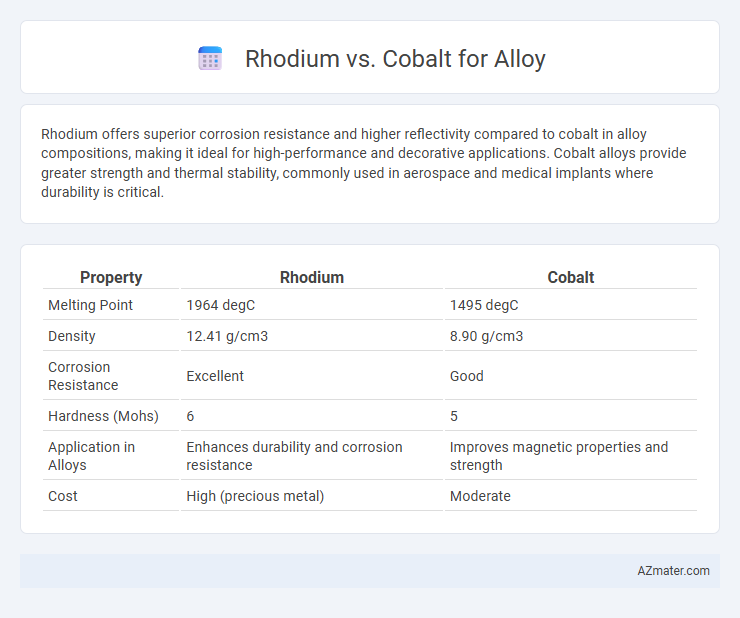Rhodium offers superior corrosion resistance and higher reflectivity compared to cobalt in alloy compositions, making it ideal for high-performance and decorative applications. Cobalt alloys provide greater strength and thermal stability, commonly used in aerospace and medical implants where durability is critical.
Table of Comparison
| Property | Rhodium | Cobalt |
|---|---|---|
| Melting Point | 1964 degC | 1495 degC |
| Density | 12.41 g/cm3 | 8.90 g/cm3 |
| Corrosion Resistance | Excellent | Good |
| Hardness (Mohs) | 6 | 5 |
| Application in Alloys | Enhances durability and corrosion resistance | Improves magnetic properties and strength |
| Cost | High (precious metal) | Moderate |
Introduction to Rhodium and Cobalt in Alloys
Rhodium, a rare and corrosion-resistant metal, is often alloyed with platinum and other metals to enhance hardness and resistance to oxidation, making it highly valuable in catalytic converters and jewelry. Cobalt, known for its high strength, magnetic properties, and heat resistance, is commonly used in hard alloys, superalloys, and batteries to improve mechanical performance and durability under extreme conditions. Both rhodium and cobalt play critical roles in specialized alloy formulations, where their unique characteristics optimize performance for industrial and technological applications.
Chemical Properties: Rhodium vs Cobalt
Rhodium exhibits exceptional corrosion resistance and high reflectivity due to its stable oxidation state and inertness, making it ideal for catalytic applications and plating. Cobalt, with its ferromagnetic properties and multiple oxidation states, excels in strength and thermal stability, commonly used in high-performance alloys and rechargeable batteries. The chemical inertness of rhodium contrasts with cobalt's reactive nature, influencing their respective alloying benefits and industrial uses.
Physical Properties and Performance
Rhodium exhibits exceptional corrosion resistance and high reflectivity, making it ideal for enhancing the durability and appearance of alloys; it has a melting point of 1964 degC and a density of 12.41 g/cm3. Cobalt alloys demonstrate superior tensile strength and excellent wear resistance, with a melting point of 1495 degC and density around 8.90 g/cm3, beneficial for high-performance applications like aerospace and medical implants. The choice between rhodium and cobalt in alloy composition depends on the required balance between hardness, corrosion resistance, and operating temperature tolerance.
Corrosion Resistance Comparison
Rhodium exhibits superior corrosion resistance compared to cobalt when used in alloys, particularly in harsh chemical environments and high-temperature applications. Rhodium's exceptional resistance to oxidation and acid attack makes it ideal for catalytic converters and jewelry, whereas cobalt alloys may demonstrate moderate corrosion resistance but are prone to oxidation and degradation under prolonged exposure. The inherent chemical inertness of rhodium significantly enhances the durability and lifespan of alloy components in corrosive conditions compared to cobalt-based alloys.
Applications in Industry
Rhodium alloys are highly valued in the automotive and chemical industries for their exceptional corrosion resistance and catalytic properties, making them ideal for catalytic converters and chemical reactor components. Cobalt alloys excel in aerospace and medical applications due to their high-temperature strength, wear resistance, and biocompatibility, often used in jet engine parts and orthopedic implants. The distinct performance characteristics of rhodium and cobalt alloys drive their specialized industrial use, optimizing durability and functionality in demanding environments.
Cost and Availability
Rhodium is significantly more expensive than cobalt, with prices often exceeding $10,000 per ounce due to its rarity and limited global supply, primarily sourced from South Africa and Russia. Cobalt, while also costly, is more abundant and has a broader production base, including the Democratic Republic of Congo, which accounts for approximately 70% of global supply, making it more accessible for alloy manufacturing. The cost disparity and availability make cobalt a more practical choice for large-scale alloy applications, whereas rhodium is reserved for specialized uses requiring exceptional corrosion resistance and catalytic properties.
Environmental Impact and Sustainability
Rhodium alloys offer superior corrosion resistance and catalytic properties, making them favorable in automotive catalytic converters, but their environmental impact is significant due to energy-intensive mining and rarity, leading to sustainability concerns. Cobalt alloys, widely used in batteries and superalloys, face challenges stemming from ethical mining practices and high ecological footprints, especially in regions with poor labor regulations. Sustainable sourcing and recycling efforts are critical in mitigating the environmental impact of both rhodium and cobalt in alloy production.
Alloying Behavior and Compatibility
Rhodium exhibits excellent corrosion resistance and enhances hardness when alloyed, making it ideal for high-performance applications requiring durability and wear resistance. Cobalt offers superior magnetic properties and thermal stability, often used to improve the strength and toughness of superalloys in extreme environments. Rhodium and cobalt demonstrate good compatibility in certain multi-component alloys, balancing cost and performance by optimizing corrosion resistance and mechanical properties.
Market Demand and Trends
Rhodium, prized for its superior corrosion resistance and catalytic properties, experiences high market demand driven by the automotive and chemical industries, with prices often spiking due to supply constraints and increased use in catalytic converters. Cobalt alloys, valued for their exceptional strength and heat resistance, see steady demand growth tied to aerospace, medical implants, and rechargeable battery production, particularly within electric vehicle markets. Current trends indicate rising cobalt demand influenced by battery technology advancements, while rhodium maintains a niche but highly volatile market influenced by regulatory emissions standards and industrial applications.
Choosing the Right Metal for Your Alloy
Rhodium offers exceptional corrosion resistance and high reflectivity, making it ideal for specialized alloys in electronics and jewelry, while cobalt provides superior strength, wear resistance, and magnetic properties suitable for aerospace and medical implants. Selecting the right metal depends on the alloy's required performance characteristics, environmental exposure, and cost considerations. For durability and magnetic functionality, cobalt is often preferred; for enhanced surface protection and aesthetic appeal, rhodium is the optimal choice.

Infographic: Rhodium vs Cobalt for Alloy
 azmater.com
azmater.com